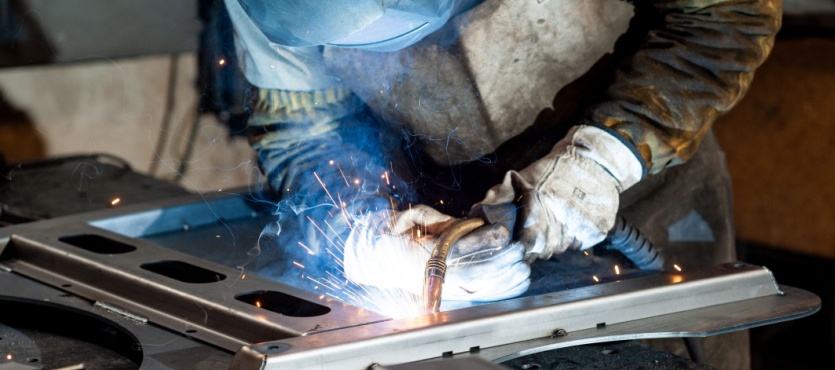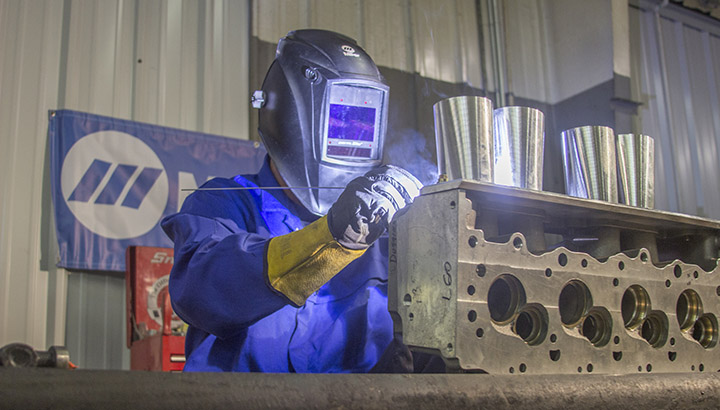Usual Welding Repair Service Issues and Just How to Address Them Effectively
Welding repair work commonly come across a series of concerns that can endanger the integrity of the end product. Typical troubles consist of inadequate infiltration, porosity, and misalignment, amongst others. Each issue offers unique difficulties that call for specific strategies for resolution. Recognizing these problems is important for welders aiming to improve their skills and end results. This discussion will explore these typical welding repair concerns and reliable methods to resolve them.
Insufficient Penetration
Poor infiltration happens when the weld metal falls short to completely fuse with the base product, resulting in weak joints and prospective architectural failings. This problem frequently originates from inadequate warmth input, inaccurate electrode angle, or incorrect welding rate. Welders may encounter inadequate penetration due to a miscalculation of the essential parameters for a specific material thickness or type. In addition, contamination on the base material's surface area can prevent effective bonding, exacerbating the trouble. To attend to inadequate penetration, welders should guarantee suitable settings on their equipment and preserve a clean job surface. Normal evaluation of welds is recommended to recognize any deficiencies early, permitting for timely adjustments and the prevention of endangered architectural honesty in bonded settings up.
Porosity
Porosity is a common flaw in welded joints that manifests as small gas bubbles trapped within the weld steel. This issue can jeopardize the stability of the weld, leading to decreased toughness and prospective failing under stress and anxiety. Montana Mobile Welding and Repair Belgrade Welding. Porosity normally emerges from contamination, dampness, or inappropriate welding methods, which permit gases to escape right into the liquified weld pool. To address porosity, welders must guarantee proper surface area preparation, keep a tidy workplace, and make use of ideal welding specifications. In addition, choosing the best filler product and securing gas can reduce gas entrapment. Routine evaluation and screening of welds can help recognize porosity early, guaranteeing timely rehabilitative actions are taken, consequently maintaining the top quality and dependability of the welded framework
Imbalance
Imbalance in welding can occur from various elements, consisting of incorrect arrangement and thermal expansion. Comprehending the source is important for effective resolution. Numerous correction techniques are available to realign parts and assure structural honesty.
Sources of Imbalance
Welding misalignment usually originates from a variety of underlying problems that can jeopardize structural stability. One key reason is improper fit-up of parts prior to welding, which can bring about gaps and unequal surface areas. Variants in thermal development during the welding procedure can also result in distortion, particularly if the materials being signed up with have various coefficients of expansion. Additionally, insufficient clamping and fixturing may stop working to hold parts firmly in location, resulting in activity during welding. Poorly conserved tools, including welding machines and tools, may introduce variances in the weld bead, further contributing to misalignment. Driver error, stemming from insufficient training or experience, can additionally play a considerable function in producing misaligned welds.

Correction Techniques Offered
Dealing with misalignment efficiently needs a combination of restorative strategies customized to the specific issues handy. One typical approach is making use of components or jigs to hold elements in the proper position during welding, making sure regular alignment. Furthermore, preheating the products can help in reducing distortion and boost fit-up. For substantial misalignment, mechanical adjustment strategies, such as using hydraulic jacks or clamps, can be employed to deal with the setting prior to welding. Post-weld warmth treatment may also be required to ease tensions triggered by misalignment. Careful examination and modification during the configuration phase can avoid misalignment problems from coming to be considerable problems, advertising a smoother welding process and boosting total structural integrity.
Distortion
Distortion is a typical difficulty in welding that can occur from various factors, consisting of uneven heating and air conditioning. Recognizing the causes of distortion is vital for carrying out effective prevention methods. Addressing this issue not just improves structural honesty however likewise boosts the overall top quality of the weld.
Root causes of Distortion
When based on the intense warm of welding, materials usually go through modifications that can lead to distortion. This phenomenon mostly develops from thermal growth and contraction throughout the welding process. As the weld location warms up, the material broadens; upon air conditioning, it acquires, which can develop interior tensions. Furthermore, unequal home heating across a workpiece can exacerbate these stress and anxieties, resulting in bending or bending. The kind of material additionally plays a substantial duty; metals with varying thermal conductivity and coefficients of expansion might react in a different way, bring about unforeseeable distortions. Additionally, inadequate joint design and inadequate fixturing can add to imbalance during welding, increasing the possibility of distortion. Understanding these reasons is important for reliable welding repair work and avoidance techniques.
Prevention Techniques
Efficient avoidance techniques for distortion throughout welding emphasis on managing warm input and guaranteeing appropriate joint layout. Keeping a consistent warmth input helps to decrease thermal development and contraction, which can cause distortion. Utilizing methods such as pre-heating the workpiece can additionally minimize the temperature level slope, promoting uniform heating. Additionally, picking ideal joint designs, such as T-joints or lap joints, can boost stability and decrease stress concentrations. Implementing correct fixturing to secure the work surfaces in place further help in keeping alignment during the welding process. Staggered welding series can distribute warmth extra uniformly, avoiding localized distortion. By using these approaches, welders can significantly decrease the probability of distortion and improve the total high quality of their welds.
Fracturing
Fracturing is an usual concern experienced in welding repairs, frequently arising from different factors such as incorrect cooling prices, product choice, or poor joint preparation. The incident of fractures can greatly jeopardize the stability of the weld, bring about possible failures throughout operation. To resolve this concern, welders should initially analyze the source, ensuring that materials work and properly chosen for the certain application. In addition, managing the air conditioning rate throughout the welding procedure is essential; quick cooling can cause tension and cause breaking. Proper joint design and prep work likewise add to minimizing the risk. Executing these approaches can improve weld high quality and toughness, eventually minimizing the chance of cracking in finished weldments.

Insufficient Combination
A considerable issue in welding repairs is insufficient blend, which happens when the weld metal does not appropriately bond with the base product or previous weld passes - Montana Mobile Welding and Repair Belgrade. This problem can cause weak points in the joint, possibly jeopardizing the stability of the bonded structure. Aspects adding to insufficient combination include not enough warm input, incorrect welding strategy, and contamination of the surface areas being signed up with. To address this issue successfully, welders must ensure correct pre-weld cleansing read more and surface area prep work, in addition to readjust their welding specifications to achieve appropriate infiltration and fusion. Normal examination throughout the welding process can additionally help identify incomplete combination early, enabling timely rehabilitative procedures to boost the overall top quality of the weld
Overheating
While welding repairs can boost structural integrity, overheating presents a considerable obstacle that can result in material destruction. Excessive warm throughout welding can change the mechanical residential or commercial properties of metals, leading to minimized toughness, increased brittleness, and bending. This sensation is specifically essential in high-stress applications where structural reliability is vital. Identifying overheating can involve visual evaluations for staining or distortion, in addition to keeping an eye on temperature throughout the welding procedure. To reduce the dangers associated with overheating, welders should employ ideal techniques, such as regulating heat input, readjusting traveling rate, and using appropriate filler materials. In addition, executing pre- and post-weld warmth therapies can assist bring back material buildings and boost the overall top quality of the fixing, guaranteeing long-lasting performance and safety and security.
Regularly Asked Concerns
What Are the Typical Indicators of a Welding Issue?

How Can I Test My Welds for Top quality?
To check welds for top quality, one can make use of visual assessments, ultrasonic screening, and radiographic techniques. Each strategy assures architectural stability, identifies flaws, and verifies adherence to specified standards, eventually improving the reliability of the bonded joints.
What Security Safety Measures Should I Take While Welding?
When welding, one should focus on safety and security by putting on appropriate individual safety equipment, ensuring correct ventilation, securing flammable products away, preserving a clean work area, and recognizing environments to avoid accidents and injuries.
Can I Fix a Weld Without Redoing the Entire Joint?
Fixing a weld without redoing the entire joint is feasible, depending upon the damage (Montana Mobile Welding and Repair Fabrication). Methods such as grinding, including filler product, or using a welding process can successfully deal with details defects while protecting the surrounding framework
What Tools Are Necessary for Reliable Welding Fixes?
Crucial tools for efficient welding repair services consist of a welding machine, wire brush, mill, safety equipment, clamps, and filler materials. Each tool plays an important role in making certain top quality and safety throughout the repair service procedure. Porosity normally develops from contamination, wetness, or incorrect welding methods, which allow gases to escape into the liquified weld swimming pool. Inadequately conserved devices, consisting of welding makers and devices, might introduce variances in the weld bead, further adding to misalignment. When subjected to the extreme heat of welding, products commonly go through adjustments that can lead to distortion. Splitting is a common concern run into in welding fixings, commonly resulting from numerous variables such as improper air conditioning rates, product option, or insufficient joint preparation. A substantial problem in welding repair work is insufficient combination, which happens when the weld steel does not properly bond with the base product or previous weld passes.